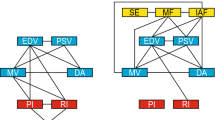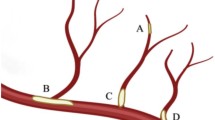Abstract
The association between cerebral hemodynamics and cognitive impairment has been reported in neurodegenerative and cerebrovascular disorders (CVD). However, it is still unclear whether changes occur in the acute phase of CVD. Here we investigated cognitive and hemodynamic parameters and their association in patients with CVD during the acute and subacute phases. Seventy-three patients with mild stroke, not undergoing endovascular treatment, were recruited. All subjects were devoid of intracranial or external carotid stenosis, significant chronic cerebrovascular pathology, dementia or non-compensated cardiovascular diseases. Patients were evaluated within 7 days from symptoms onset (T1) and after 3 months (T2). Clinical and demographic data were collected. NIHSS, MoCA, FAB, and Word-Color Stroop test (WCST) were used to evaluate disease severity and cognitive functions. Basal hemodynamic parameters in the middle cerebral artery were measured with transcranial Doppler. Differences between T2 and T1, correlations between cognitive and hemodynamic variables at T1 and T2, as well as correlations between the T2-T1 variation in cognitive and hemodynamic parameters were assessed. At T1, cognitive performance of MoCA, FAB, and WCST was lower compared with T2; and pulsatility index, a parameter reflecting distal vascular resistance, was higher. However, no correlations between the changes in cognitive and hemodynamic variables were found; therefore, the two seems to be independent phenomena. In the acute phase, the linear association between cerebral blood flow and cognitive performances was lost, probably due to a differential effect of microenvironment changes and vascular-specific phenomena on cognition and cerebral hemodynamics. This relationship was partially restored in the subacute phase.



Similar content being viewed by others
Data availability
The datasets generated during and/or analyzed during the current study are available from the corresponding author on reasonable request.
References
Claassen JAHR, Thijssen DHJ, Panerai RB, Faraci FM (2021) Regulation of cerebral blood flow in humans: physiology and clinical implications of autoregulation. Physiol Rev 101:1487–1559. https://doi.org/10.1152/physrev.00022.2020
Kugler EC, Greenwood J, MacDonald RB (2021) The “Neuro-Glial-Vascular” Unit: the role of glia in neurovascular unit formation and dysfunction. Front Cell Dev Biol 9:732820. https://doi.org/10.3389/fcell.2021.732820
Herzig R, Hlustík P, Skoloudík D et al (2008) Assessment of the cerebral vasomotor reactivity in internal carotid artery occlusion using a transcranial Doppler sonography and functional MRI. J Neuroimaging 18:38–45. https://doi.org/10.1111/j.1552-6569.2007.00168.x
Valdueza JM, Balzer JO, Villringer A et al (1997) Changes in blood flow velocity and diameter of the middle cerebral artery during hyperventilation: assessment with MR and transcranial Doppler sonography. AJNR Am J Neuroradiol 18:1929–1934
Herrera CRC, Beltramini GC, Avelar WM et al (2016) Cerebral vasomotor reactivity assessment using transcranial Doppler and MRI with apnea test. Braz J Med Biol Res 49:e5437. https://doi.org/10.1590/1414-431X20165437
Sun J-H, Tan L, Yu J-T (2014) Post-stroke cognitive impairment: epidemiology, mechanisms and management. Ann Transl Med 2:80. https://doi.org/10.3978/j.issn.2305-5839.2014.08.05
van Rooij FG, Kessels RPC, Richard E et al (2016) Cognitive impairment in transient ischemic attack patients: a systematic review. Cerebrovasc Dis 42:1–9. https://doi.org/10.1159/000444282
Riepe MW, Riss S, Bittner D, Huber R (2004) Screening for cognitive impairment in patients with acute stroke. Dement Geriatr Cogn Disord 17:49–53. https://doi.org/10.1159/000074082
Rost NS, Brodtmann A, Pase MP et al (2022) Post-stroke cognitive impairment and dementia. Circ Res 130:1252–1271. https://doi.org/10.1161/CIRCRESAHA.122.319951
Leśniak M, Bak T, Czepiel W et al (2008) Frequency and prognostic value of cognitive disorders in stroke patients. Dement Geriatr Cogn Disord 26:356–363. https://doi.org/10.1159/000162262
Sforza M, Bianchini E, Alivernini D et al (2022) The impact of cerebral vasomotor reactivity on cerebrovascular diseases and cognitive impairment. J Neural Transm (Vienna) 129:1321–1330. https://doi.org/10.1007/s00702-022-02546-w
Sivakumar L, Riaz P, Kate M et al (2017) White matter hyperintensity volume predicts persistent cognitive impairment in transient ischemic attack and minor stroke. Int J Stroke 12:264–272. https://doi.org/10.1177/1747493016676612
Altmann M, Thommessen B, Rønning OM et al (2016) Middle cerebral artery pulsatility index is associated with cognitive impairment in lacunar stroke. J Neuroimaging 26:431–435. https://doi.org/10.1111/jon.12335
Viticchi G, Falsetti L, Potente E et al (2021) Impact of carotid stenosis on cerebral hemodynamic failure and cognitive impairment progression: a narrative review. Ann Transl Med 9:1209. https://doi.org/10.21037/atm-20-7226
von Reutern G-M, Goertler M-W, Bornstein NM et al (2012) Grading carotid stenosis using ultrasonic methods. Stroke 43:916–921. https://doi.org/10.1161/STROKEAHA.111.636084
Fazekas F, Chawluk JB, Alavi A et al (1987) MR signal abnormalities at 1.5 T in Alzheimer’s dementia and normal aging. AJR Am J Roentgenol 149:351–356. https://doi.org/10.2214/ajr.149.2.351
Brott T, Adams HP, Olinger CP et al (1989) Measurements of acute cerebral infarction: a clinical examination scale. Stroke 20:864–870. https://doi.org/10.1161/01.str.20.7.864
Saver JL, Chaisinanunkul N, Campbell BCV et al (2021) Standardized nomenclature for modified Rankin Scale global disability outcomes: consensus recommendations from Stroke Therapy Academic Industry Roundtable XI. Stroke 52:3054–3062. https://doi.org/10.1161/STROKEAHA.121.034480
Nasreddine ZS, Phillips NA, Bédirian V et al (2005) The Montreal Cognitive Assessment, MoCA: a brief screening tool for mild cognitive impairment. J Am Geriatr Soc 53:695–699. https://doi.org/10.1111/j.1532-5415.2005.53221.x
Dubois B, Slachevsky A, Litvan I, Pillon B (2000) The FAB: a Frontal Assessment Battery at bedside. Neurology 55:1621–1626. https://doi.org/10.1212/wnl.55.11.1621
Stroop JR (1935) Studies of interference in serial verbal reactions. J Exp Psychol 18:643–662. https://doi.org/10.1037/h0054651
Scarpina F, Tagini S (2017) The Stroop Color and Word Test. Front Psychol 8:557. https://doi.org/10.3389/fpsyg.2017.00557
Edwards JD, Jacova C, Sepehry AA et al (2013) A quantitative systematic review of domain-specific cognitive impairment in lacunar stroke. Neurology 80:315–322. https://doi.org/10.1212/WNL.0b013e31827deb85
Lapi D, Colantuoni A (2015) Remodeling of cerebral microcirculation after ischemia-reperfusion. J Vasc Res 52:22–31. https://doi.org/10.1159/000381096
Suministrado MSP, Shuang EWY, Xu J et al (2017) Poststroke cognitive decline is independent of longitudinal changes in cerebral hemodynamics parameters. J Neuroimaging 27:326–332. https://doi.org/10.1111/jon.12395
Kidwell CS, el-Saden S, Livshits Z et al (2001) Transcranial Doppler pulsatility indices as a measure of diffuse small-vessel disease. J Neuroimaging 11:229–235. https://doi.org/10.1111/j.1552-6569.2001.tb00039.x
Salinet ASM, Panerai RB, Robinson TG (2014) The longitudinal evolution of cerebral blood flow regulation after acute ischaemic stroke. Cerebrovasc Dis Extra 4:186–197. https://doi.org/10.1159/000366017
Sabayan B, Jansen S, Oleksik AM et al (2012) Cerebrovascular hemodynamics in Alzheimer’s disease and vascular dementia: a meta-analysis of transcranial Doppler studies. Ageing Res Rev 11:271–277. https://doi.org/10.1016/j.arr.2011.12.009
Ogoh S (2017) Relationship between cognitive function and regulation of cerebral blood flow. J Physiol Sci 67:345–351. https://doi.org/10.1007/s12576-017-0525-0
Leeuwis AE, Smith LA, Melbourne A et al (2018) Cerebral blood flow and cognitive functioning in a community-based, multi-ethnic cohort: the Sabre study. Front Aging Neurosci 10:279. https://doi.org/10.3389/fnagi.2018.00279
Uzuner N, Özdemir Ö, Tekgöl Uzuner G (2013) Relationship between pulsatility index and clinical course of acute ischemic stroke after thrombolytic treatment. Biomed Res Int 2013:265171. https://doi.org/10.1155/2013/265171
Chi N-F, Hu H-H, Chan L et al (2020) Impaired cerebral autoregulation is associated with poststroke cognitive impairment. Ann Clin Transl Neurol 7:1092–1102. https://doi.org/10.1002/acn3.51075
Freitas-Andrade M, Raman-Nair J, Lacoste B (2020) Structural and functional remodeling of the brain vasculature following stroke. Front Physiol 11:948. https://doi.org/10.3389/fphys.2020.00948
Iadecola C, Smith EE, Anrather J et al (2023) The neurovasculome: key roles in brain health and cognitive impairment: a scientific statement from the American Heart Association/American Stroke Association. Stroke 54:e251–e271. https://doi.org/10.1161/STR.0000000000000431
van Veluw SJ, Hou SS, Calvo-Rodriguez M et al (2020) Vasomotion as a driving force for paravascular clearance in the awake mouse brain. Neuron 105:549-561.e5. https://doi.org/10.1016/j.neuron.2019.10.033
Greenberg SM, Bacskai BJ, Hernandez-Guillamon M et al (2020) Cerebral amyloid angiopathy and Alzheimer disease - one peptide, two pathways. Nat Rev Neurol 16:30–42. https://doi.org/10.1038/s41582-019-0281-2
Forró T, Bajkó Z, Bălașa A, Bălașa R (2021) Dysfunction of the neurovascular unit in ischemic stroke: highlights on microRNAs and exosomes as potential biomarkers and therapy. Int J Mol Sci 22:5621. https://doi.org/10.3390/ijms22115621
Wang L, Xiong X, Zhang L, Shen J (2021) Neurovascular unit: a critical role in ischemic stroke. CNS Neurosci Ther 27:7–16. https://doi.org/10.1111/cns.13561
Jordan JD, Powers WJ (2012) Cerebral autoregulation and acute ischemic stroke. Am J Hypertens 25:946–950. https://doi.org/10.1038/ajh.2012.53
Wang C, Miao P, Liu J et al (2019) Cerebral blood flow features in chronic subcortical stroke: Lesion location-dependent study. Brain Res 1706:177–183. https://doi.org/10.1016/j.brainres.2018.11.009
Toyoda K, Minematsu K, Yamaguchi T (1994) Long-term changes in cerebral blood flow according to different types of ischemic stroke. J Neurol Sci 121:222–228. https://doi.org/10.1016/0022-510x(94)90356-5
Salinet ASM, Robinson TG (1985) Panerai RB (2015) Effects of cerebral ischemia on human neurovascular coupling, CO2 reactivity, and dynamic cerebral autoregulation. J Appl Physiol 118:170–177. https://doi.org/10.1152/japplphysiol.00620.2014
Aries MJ, Elting JW, Stewart R et al (2013) Cerebral blood flow velocity changes during upright positioning in bed after acute stroke: an observational study. BMJ Open 3:e002960. https://doi.org/10.1136/bmjopen-2013-002960
Venkatakrishnan S, Khanna M, Gupta A (2022) Transcranial color coded duplex sonography findings in stroke patients undergoing rehabilitation: an observational study. J Neurosci Rural Pract 13:129–133. https://doi.org/10.1055/s-0041-1742158
Salinet AS, Silva NC, Caldas J et al (2019) Impaired cerebral autoregulation and neurovascular coupling in middle cerebral artery stroke: influence of severity? J Cereb Blood Flow Metab 39:2277–2285. https://doi.org/10.1177/0271678X18794835
Author information
Authors and Affiliations
Contributions
Conceptualization, Michela Sforza, Edoardo Bianchini and Giuliano Sette; methodology, Michela Sforza and Giuliano Sette; formal analysis, Edoardo Bianchini.; participants recruitment, Michela Sforza, Edoardo Bianchini and Diletta Alivernini; investigation, Michela Sforza, Diletta Alivernini, Alessandra Spalloni, Valentina Teresi, Irene Madonia, and Giuliano Sette; data curation, Michela Sforza and Edoardo Bianchini; writing—original draft preparation, Michela Sforza and Edoardo Bianchini; writing—review and editing, Diletta Alivernini, Alessandra Spalloni, Valentina Teresi, Irene Madonia, Marco Salvetti, Francesco E. Pontieri, and Giuliano Sette; supervision, Francesco E. Pontieri and Giuliano Sette. All authors have read and agreed to the published version of the manuscript.
Corresponding author
Ethics declarations
Ethics approval
Ethical approval was granted by the Local Ethical Committee of Sapienza University of Rome (Ref. CE 6584_2021). The study was conducted in accordance with the Declaration of Helsinki and its later amendments. Data collection and processing followed the current European regulation for data protection.
Consent to participate
Written informed consent was obtained from all individual participants included in the study.
Consent for publication
Patients signed informed consent regarding publishing their data.
Conflict of interest
The authors declare no competing interests.
Additional information
Publisher's note
Springer Nature remains neutral with regard to jurisdictional claims in published maps and institutional affiliations.
Michela Sforza and Edoardo Bianchini contributed equally to the work and share co-first authorship.
Rights and permissions
Springer Nature or its licensor (e.g. a society or other partner) holds exclusive rights to this article under a publishing agreement with the author(s) or other rightsholder(s); author self-archiving of the accepted manuscript version of this article is solely governed by the terms of such publishing agreement and applicable law.
About this article
Cite this article
Sforza, M., Bianchini, E., Alivernini, D. et al. Cerebral hemodynamics and cognitive functions in the acute and subacute stage of mild ischemic stroke: a longitudinal pilot study. Neurol Sci 45, 2097–2105 (2024). https://doi.org/10.1007/s10072-023-07260-3
Received:
Accepted:
Published:
Issue Date:
DOI: https://doi.org/10.1007/s10072-023-07260-3




